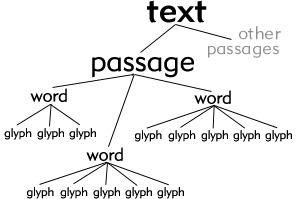It's Alive! is the mutant offspring of Microsoft Word and Adobe AfterAffects. Hopefully it is as easy to use as the former, and as capable of creating interesting effects as the latter.
It's Alive! is based on the ActiveText architecture. Most word-handling programs see text documents as one long stream of characters, with markups to denote where one font ends and another begins, what is bold, what is red, etc. ActiveText sees documents as composed of glyphs, words, passages and texts objects:
Why does ActiveText parse text in this particular way? For many reasons, the foremost being that it makes it much easier to apply interesting behaviors to meaningful chunks of text. The user (that's you) can take a passage and assign it a "cruise" behavior so it wanders around the screen. Then she can take the first word of that passage and have it "vibrate". Then she can take the first glyph of that word and have it follow the mouse.
What's even more interesting, the user can apply "viral" to the entire passage. Now, when any member of that passage encounters text which belongs to another passage, all of the behaviors from the first passage will get transferred to the second passage, i.e., the first infects the other.
This is not impossible to do in a standard stream model of text. It is just much, much harder.
Another major advantage of the ActiveText way is it allows us to plug-in fonts in which the letterforms themselves are dynamic and interactive. We call these fonts SoftType. They are based on TrueType fonts, so they will work with any fonts loaded onto your Windows machine. They can do crazy stuff like follow the mouse around like a bunch of magnetic filings and then resume their shape (Pull), or deform wildly in response to the mouse moving over them (Pulse).
Yet a third big advantage is that ActiveText supports "continous editing". In most dynamic environments, you edit in a static mode and then say "go" and everything takes off. In It's Alive!, you can edit in either static or dynamic (or "simulate") mode. Well, actually, you can edit most things. You can apply behaviors and change typographic qualities (font, size, color, SoftType...) in dynamic mode. You can't add or delete glyphs - yet. We have it working but are not 100% that it is completely bug-free. The next version will allow this.
If you are really interested in all the sordid details, you can read a paper Alex and I just submitted to the User Interface and Software Technology conference.
